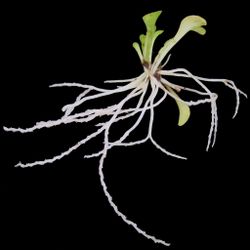| Genlisea | |
|---|---|

| |
| Genlisea violacea traps and leaves | |
| Scientific classification | |
| Kingdom: | |
| Division: | |
| Class: | |
| Order: | |
| Family: | |
| Genus: | Genlisea
|
| Species | |
|
See text. | |
Genlisea is a genus of carnivorous plants also known as corkscrew plants. The 21 species grow in wet terrestrial to semi-aquatic environments distributed throughout Africa and Central and South America. The plants use highly modified underground leaves to attract, trap and digest minute microfaunaca, particularly protozoans. Although suggested a century earlier by Charles Darwin, carnivory in the genus wasn't proven until 1998.[1]
The generic name Genlisea honors the late Stéphanie Félicité Ducrest de St-Albin, comtesse de Genlis, a French writer and educator.[2]
Two member of the genus, G. margaretae and G. aurea, possess the smallest and second smallest known genomes of all flowering plants.[3]
Description edit
Genlisea are small herbs, growing from a slender rhizome and bearing two morphologically distinct leaf types - photosynthetic foliage leaves aboveground and highly modified subterranean leaves used to trap prey. The plants lack roots, although the subterranean traps perform many of the functions, such as anchorage and water absorption, normally performed by roots.
Several to many flowers are held by a slender, erect, and often tall inflorescence. As in other members of the bladderwort family, the corolla is fused into a bilobed tube tapering to a spur, with the lower lip of the corolla having three lobes.[2] The calyx is five-lobed, in contrast to Utricularia's three-lobed calyx.[4] Corolla colors are generally yellow or violet to mauve, although a few species are white or cream.[4]
The foliage leaves grow in a hemisphere around the growth point. Depending on species, these leaves are linear to spatulate in shape and 0.5–5 cm (¼–2 in) in length.[2]
The subterranean traps are white, lacking chlorophyll or any other pigmentation. They consist of a cylindrical stalk, widening at some distance below the surface into a hollow bulb-like utricle, and continuing as a hollow cylinder some further distance. At this point the stalk bifurcates into two furrowed spirals, between which the cylinder opening acts as the trap entrance. The furrows of the spiraled trap arms are lined with hairs pointing inward and toward the bifurcation. The hollow cylinder section leading from the bifurcation to the utricle is likewise lined with upward-pointing curved hairs. Some species produce two trap forms, one shorter and one longer, which probably target different prey groups.
Carnivory edit
Like all members of the bladderwort family, Genlisea attract, trap, and digest microfaunal prey to supplement the poor nutritional availability of their environment.
Early researchers noted that the utricles filled up with copepods, nematodes, and other minute organisms. This observation, as well as the unique terrestrial leaf morphology of the genus, prompted Darwin to surmise genus was likely carnivorous, though he .[5]
Chemotaxis hypothesis edit
Artificial airspace hypothesis edit
Taxonomy edit
Intraspecific determination is depends almost wholly upon the inflorscence, particularly upon the indumentum.[4]
| Species | Subgenus | Distribution | Species | Subgenus | Distribution | |
|---|---|---|---|---|---|---|
| G. africana | Genlisea | Africa | G. pallida | Genlisea | Africa | |
| G. angolensis | Genlisea | Africa | G. pygmaea | Genlisea | South America | |
| G. aurea | Genlisea | South America | G. repens | Genlisea | South America | |
| G. barthlottii | Genlisea | G. roraimensis | Genlisea | South America | ||
| G. filiformis | Genlisea | Africa | G. sanariapoana | Genlisea | South America | |
| G. glabra | Genlisea | South America | G. stapfii | Genlisea | Africa | |
| G. glandulosissima | Genlisea | Africa | G. subglabra | Genlisea | Africa | |
| G. guianensis | Genlisea | South America | G. taylorii | Genlisea | ||
| G. hispidula | Genlisea | Africa | G. uncinata | Tayloria | South America | |
| G. lobata | Tayloria | South America | G. violacea | Tayloria | South America | |
| G. margaretae | Genlisea | Africa |
Distribution and habitat edit
Botanical history edit
The genus was discovered by Augustin François César Prouvençal de Saint-Hilaire,[2] who in 1833 described four species: G. aurea, G. filiformis, G. pygmaea, and G. violacea.
Cultivation edit
References edit
- ^ Barthlott, W., Porembski, S., Fischer, E. & Gemmel, B. (1998). First protozoa-trapping plant found. Nature, 392(6675): 447.
- ^ a b c d Claudi-Magnussen, Glenn (1982) An Introduction to Genlisea. Carnivorous Plant Newsletter 11(1):13-15
- ^ Greilhuber, J., Borsch, T., Müller, K., Worberg, A., Porembski, S., and Barthlott, W. (2006). Smallest angiosperm genomes found in Lentibulariaceae, with chromosomes of bacterial size. Plant Biology, 8: 770-777.
- ^ a b c Taylor, Peter (1991) The Genus Genlisea. Carnivorous Plant Newsletter 20(1-2):20-26
- ^ Darwin, C. R. 1875. Insectivorous Plants. London: John Murray.